Audemars Piguet was founded in 1875 in Le Brassus in the Vallée de Joux, while Patek Philippe was founded in 1839 in Geneva. Both manufacturers remain under family ownership—a rarity in the watch industry that is dominated by luxury groups. But while President Thierry Stern has been following in his father’s footsteps since 2009, leading Patek Philippe very carefully along traditional pathways, François-Henry Bennahmias has changed a great deal at Audemars Piguet since taking over in 2012 and sales have multiplied. This started with the sales structure, making it almost independent of jewellers and thereby relying entirely on a limited number of boutiques of its own. Special editions include Marvel heroes and designs that highlight street art and pop culture. Bennahmias plans to conclude his tenure at Audemars Piguet at the end of 2023, and this may allow the entry of another strategy.
Icons
 Above: The original Nautilus from 1976 and the first Royal Oak from 1972. Below: The Nautilus Ref. 5811 and the Royal Oak Jumbo
Above: The original Nautilus from 1976 and the first Royal Oak from 1972. Below: The Nautilus Ref. 5811 and the Royal Oak Jumbo
The two brands have been pursuing very different strategies with their most iconic designs over the last several years. When Thierry Stern saw the enormous growth and attention around the Nautilus, he halted the production of its three-hand steel model, without producing a successor, to promote the sale of more elegant models with complications. On the other hand, Bennahmias expanded the Royal Oak collection and polarised its audience with new design ideas and influences, like the DJ version with an equaliser look on the dial and crown guards.
These two flagship models have a similar history. In 1972, the famous watch designer Gérald Genta designed the Royal Oak for Audemars Piguet. It is known for its octagonal bezel on a round case, eight prominent hexagonal screws, the unique Tapisserie pattern on the dial, and an integrated metal bracelet.
At the beginning, the Royal Oak had a 39-mm case diameter, which was considered to be so large for the time it became known as the “Jumbo”. The stainless-steel watch was also expensive; it was priced higher than most gold watches.
After the Royal Oak, Genta also designed the Nautilus for Patek Philippe, which was introduced in 1976. Its price point was even higher. Advertisements for the first model, Ref. 3700, teased potential customers with this statement: “One of the world’s most expensive watches is made of steel.” Its shape also caught the world’s attention with a bezel that was neither truly round nor square, but an octagon with rounded edges. Its 42-mm diameter made the Nautilus ahead of its time and exceeded the size of the Royal Oak by 3mm.
The inspiration for this unusual case and its construction, with a hinge on one side and a lock on the other, can be traced back to the design of a ship’s porthole. Textured grooves on the dial and an integrated metal bracelet added character and recognisability. At this time, Patek Philippe was almost exclusively building horological complications, such as perpetual calendars and minute repeaters. Despite initial doubts as to whether such a large and sporty watch would fit the brand’s character, Patek introduced the watch under the Nautilus name.
It not only looks like a porthole, the sides serve to attach the bezel to the case body, just like the opening of a ship’s window. The movement and dial must be removed from the front of the watch for servicing. This construction was necessary at the time to achieve the high level of water resistance of 120 metres. With the Nautilus name, Patek Philippe emphasised an important aspect of the watch—namely, a very high water resistance for the time.
Advertisements of the day pictured the Nautilus on two differently dressed wrists, showing the reader that the watch could be worn with a wet suit just as well as with a tuxedo.
The first Nautilus Ref. 3700 was powered by the thin automatic movement 28-255, which Jaeger-LeCoultre developed in 1967 for Vacheron Constantin, Patek Philippe, and Audemars Piguet. It was also used in the first Royal Oak as the Caliber 2121. The similarities are remarkable: Same decade, same creator, same design, same movement.
By the end of 2021, Patek Philippe halted production of the popular Ref. 5711, which was similar to the original Nautilus, but with the exception of the central seconds, which was not present in 1976. The demand was so great that this steel model was traded at around €220,0004, more than seven times higher than the retail price.
If we look at only the men’s watches, in addition to the three-hand Ref. 5811, which is currently only available in white gold, there are models with a perpetual calendar, chronograph, chronograph with a second time zone, and a Nautilus with a power-reserve indication, pointer date, and moonphase. At Audemars Piguet, the Royal Oak is by far its most important watch collection to date. It is currently available with a second time zone, chronograph, perpetual calendar, equation of time, tourbillon, and even the Grande Complication with a minute repeater, perpetual calendar, and chronograph.
 The Royal Oak Perpetual Calendar Ref. 26579CS.OO.1225CS.01 and the Nautilus Travel Time Chronograph Ref. 5990/1A
The Royal Oak Perpetual Calendar Ref. 26579CS.OO.1225CS.01 and the Nautilus Travel Time Chronograph Ref. 5990/1AOver the years, Audemars Piguet has not only built the Royal Oak with a variety of complications; it has also used different materials, even gold and platinum, to change the character of the watch. Although this contradicts its original philosophy of understatement, it reflects customer demand.
Because of the number of case components, the Royal Oak also works well as a two-tone watch. Audemars Piguet produces various models made of steel and yellow or rose gold. The Royal Oak Perpetual Calendar stands out with a case and bracelet made completely of black or blue ceramic. Its satin-finish surfaces, like other watches in the collection, highlight the effort and expertise required when working with the extremely hard ceramic material.
This modern material creates an entirely different appearance, but simpler measures like leather straps in the dial colour or contrasting subdials on the chronographs also provide exciting variations for the Royal Oak.
There is an ultra-slim version that largely corresponds to the original model with a blue-grey dial, 39-mm diameter, and the thin automatic Calibre 2121. The 41-mm versions with the more modern in-house 3120 movement and most other versions have an updated look. Hands and markers are no longer rounded as before but achieve a similar shape with complex edges and bevels. The original blue dial is a typical element on many Royal Oak models, although black and silver dials are also used.
The Movement as a Design Element
 The Royal Oak Concept Black Panther Flying Tourbillon
The Royal Oak Concept Black Panther Flying TourbillonExposed and skeletonised movements, visible from the front, have become a standard feature of the Royal Oak series. The movements themselves have become a design element. A variety of colours and skeletonised bridges allow for the opportunity of new variations. In 1993, Audemars Piguet furthered the concept of the luxury sports watch with the Royal Oak Offshore—even sportier, even more complex, and even more technical in appearance. Because of its 42-mm-diameter case, the watch was called “The Beast”. In the meantime, this case size has become established as the standard for chronographs; Audemars Piguet has since added larger models to its collection.
 Royal Oak Offshore Chronograph Ref. 26420SO.OO.A600CA.01
Royal Oak Offshore Chronograph Ref. 26420SO.OO.A600CA.01The Offshore enjoyed a boost thanks to celebrities like Arnold Schwarzenegger. In collaboration with Audemars Piguet, the actor introduced larger and larger editions, including the Royal Oak Offshore T3 Chronograph in conjunction with the 2003 film Terminator 3. With its 52.5-mm diameter, it is still the largest Royal Oak. Even among the Offshore collection, there are numerous complications and variations. Its appearance is defined by a variety of materials, like forged carbon, which gives its surface an intriguing cloudy appeal.
Audemars Piguet recently added new and unusual accents to this luxury sports watch collection. Dials and rubber straps pop in bright orange, yellow, and lime green. This is another way the Royal Oak is breaking taboos.
The most extraordinary appearance in the Royal Oak family is perhaps the Royal Oak Concept, first introduced in 2002. A unique case design with geometric lines and innovative materials and technologies in the movement are typical. The technical focus of this line is reflected in modern case materials like forged carbon, ceramic, and blackened titanium. Audemars Piguet always omits the dial and uses a track on the rehaut or movement bridges. The movements are partially skeletonised, but always with a clearly technical appeal that includes three-dimensional shapes, special surface finishes, and even unusual materials within the movement, such as ceramic.
The newest version is the Supersonnerie, which fulfils the innovative aspirations of the Concept line with a completely redesigned minute repeater. Its increased volume—significantly louder than any other repeater—is due to an innovative chiming mechanism and sophisticated case technology.
Classic, Sporty, Technical
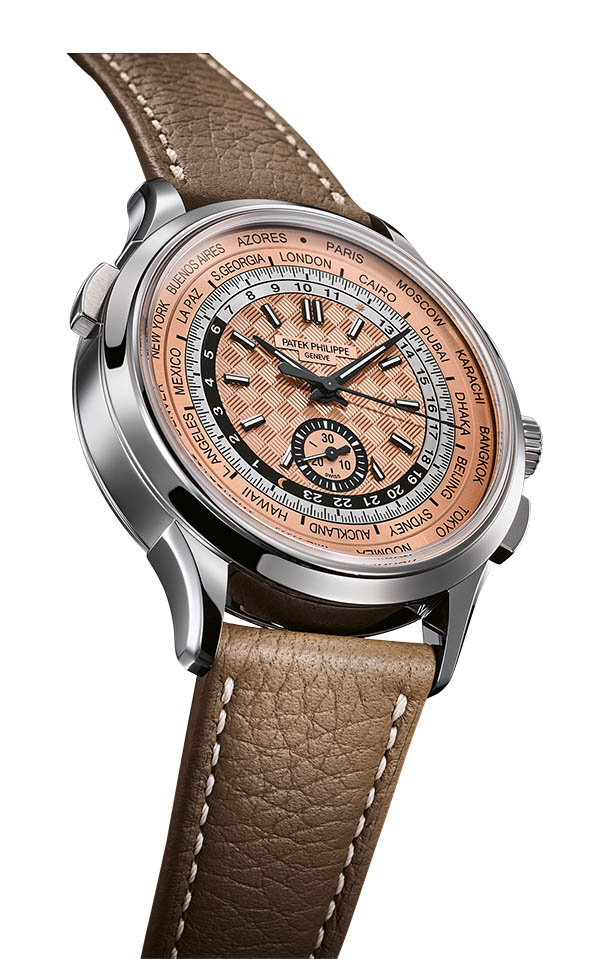 Patek Philippe Worldtime display Ref. 5935A
Patek Philippe Worldtime display Ref. 5935AThere is a clear and fundamental division into classic, sporty, and technical categories for the Royal Oak, Royal Oak Offshore, and Royal Oak Concept collections. Generally, however, they are all undergoing very clear modernisation with new materials, surface treatments, and colours.
Audemars Piguet updated the collection in 2022 to mark the 50th anniversary of the Royal Oak. The popular ultrathin “Jumbo”, which resembled the original model with a blue-grey dial, 30-mm diameter, and thin automatic 2121 movement, was replaced in this anniversary year by a successor powered by an in-house movement. Its external features remained largely unchanged. These include the characteristic Petite Tapisserie dial pattern made up of hundreds of small, flat, pyramids on a square base, which is milled from the thin metal plate that forms the dial using a traditional guilloché machine to create the matrix pattern. At the same time, the squares are separated from one another by narrow diamond-cut grooves. The displays remain limited to two hands and a date.
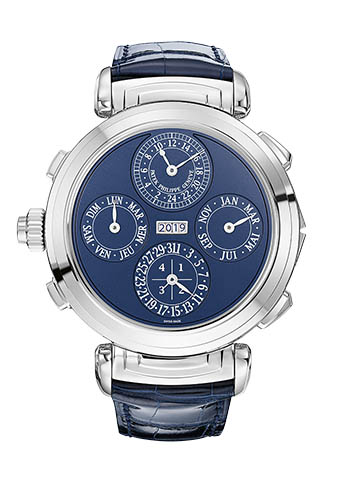 Patek Philippe Grandmaster Chime with reversible case and two dials
Patek Philippe Grandmaster Chime with reversible case and two dialsThe newly developed in-house Calibre 7121 replaces the 2121, which had powered the model for 50 years. While the design of the Jumbo continues to be based on the original model, Audemars Piguet has updated the appearance of other 2022 models.
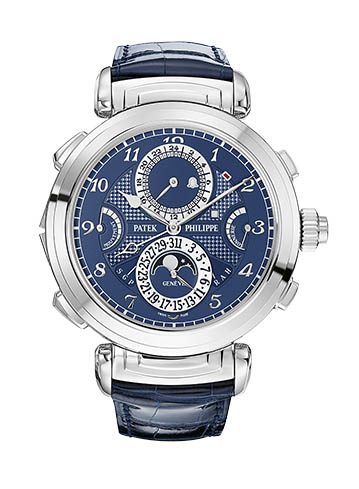 Patek Philippe Grandmaster Chime with reversible case and two dials
Patek Philippe Grandmaster Chime with reversible case and two dials
Complications
Complicated watches are part of the tradition of both brands. Especially in the second half of the 19th and the first half of the 20th century, one record rapidly followed another. In 1882, Audemars Piguet introduced the first Grande Complication with a minute repeater, chronograph, and perpetual calendar, and created another masterpiece in 1921 with the smallest minute repeater. By 1870, Patek Philippe was also building a pocket watch chronograph, and in 1906, a watch with an astronomical display. In 1909, Patek created a pocket watch with sonnerie, minute repeater, and Westminster chime.
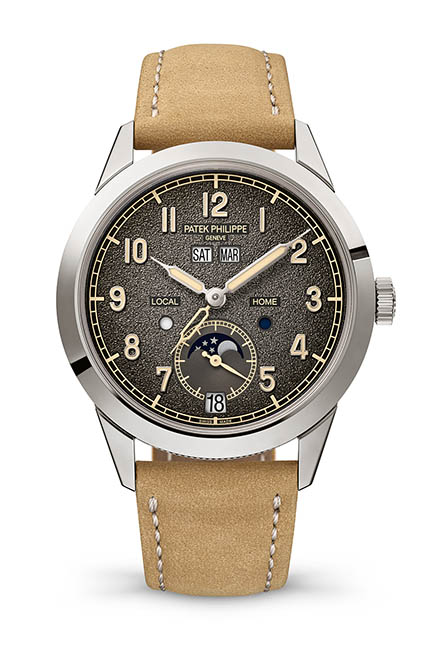 Patek Philippe Annual Calendar
Patek Philippe Annual CalendarIt did not take long for complications to be integrated into the smaller, more delicate movements made for wristwatches. Audemars Piguet introduced the first wristwatch with a minute repeater in 1892. Patek Philippe presented the first wristwatch with flyback chronograph in 1923, followed in 1925, by the first wristwatch with a perpetual calendar and the first wristwatch with a world-time indication in 1937.
The combination of several complications presents a special challenge. The difficulty grows exponentially, not just as a matter of simple addition. The mechanisms must often be integrated next to one another in the movement and specially designed to save space. The assembly and adjustment of a complication is made more difficult by each
additional one.
Overcoming difficulties and winning records is a common characteristic of people with great ambition. Two US entrepreneurs, James Ward Packard and Henry Graves, competed to create the world’s most complicated watch. Both commissioned several watches from Patek Philippe. Between 1900 and 1927, Packard alone ordered 13 complicated timepieces. The last to be delivered had the most additional functions: A minute repeater with carillon (three gongs), a perpetual calendar with moonphase, sunrise and sunset times, an equation of time, and a display of the night sky.
Only five years later, in 1932, Patek Philippe created the most complicated “Supercomplication” for Graves. The pocketwatch included a minute repeater, sonnerie with Westminster chime, a perpetual calendar with moonphase, split-seconds chronograph, alarm, sidereal time, sunrise and sunset indication, an equation of time, and a star chart.
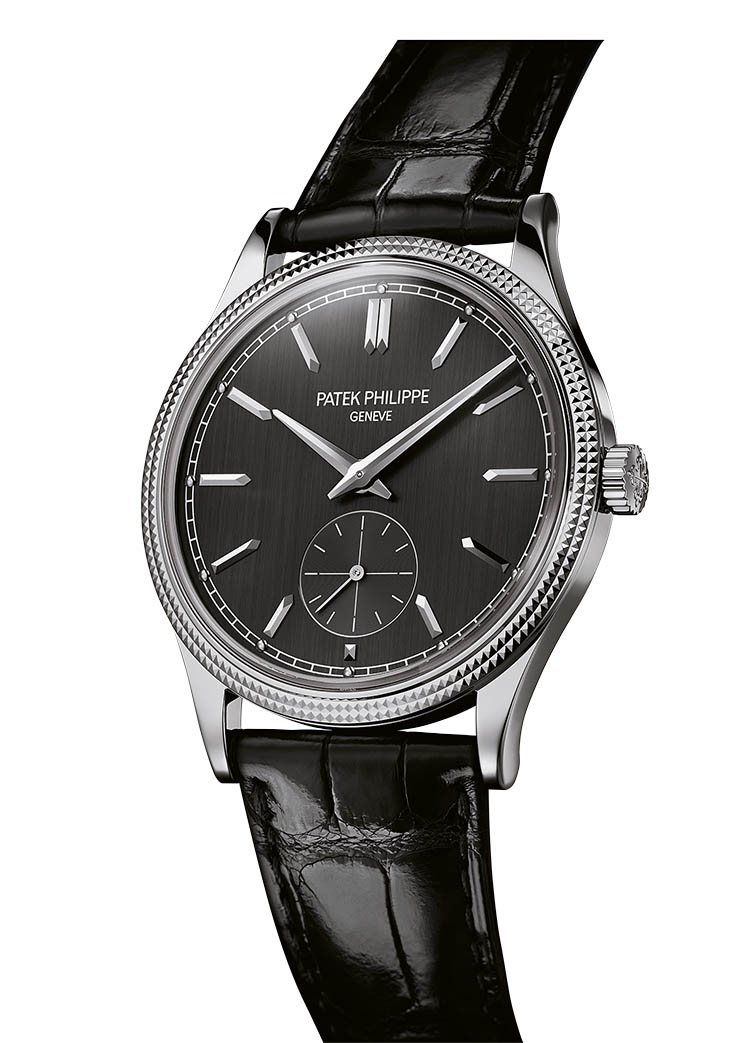 Patek Philippe Calatrava
Patek Philippe CalatravaIn 2014, the Supercomplication achieved the highest price ever for a watch at a Sotheby’s auction—23.237 million Swiss francs. The extraordinary features of this watch were exceeded only in 1989, when Patek Philippe introduced the pocket watch Calibre 89 with 33 complications to mark its 150th anniversary. This watch has two dials, eight display discs, 24 hands, and a movement comprising 1,728 individual parts. The front shows a secular perpetual calendar with four-digit year indication, moonphase and age, a split-seconds chronograph and a second time zone. The back shows astronomical displays like sidereal time, an equation of time, sunrise and sunset times, seasons, solstices, as well as equinoxes, the signs of the zodiac, and a rotating star chart. Acoustic indications include grande and petite sonnerie, a minute repeater on four gongs and an alarm on a fifth gong.
The watch was awarded several patents: The date display for Easter, which can vary by more than four weeks, as well as for the secular perpetual calendar, whose date is based on a 400-year cycle and requires no correction until the 28th century. While the watches created for Graves and Packard were single-production pieces, Patek Philippe built four pieces of the Caliber 89.
Patek Philippe continued the series of extremely complicated pocket watches in 2000 with the Star Caliber 2000 with 21 functions, including a perpetual calendar, sunrise and sunset display, an equation of time and a star chart. The following year, Patek Philippe presented the Sky Moon Tourbillon, an ultra-complicated wristwatch with front and back dial, which continues to be a part of the collection. This model has a perpetual calendar, minute repeater, tourbillon, sidereal time, star chart, moonphases, and angular momentum displays.
The next record followed in 2014, when the company launched its most complicated wristwatch, the Grandmaster Chime. The two-dial watch can be worn showing either face, has 20 functions, and a movement containing 1,366 individual components. The watch has five chiming functions—grande and petite sonnerie, a minute repeater, a recently patented date repeater, and an alarm. It also has a perpetual calendar with moonphase and second time zone.
Audemars Piguet may not have as many records but, as mentioned earlier, it built the first Grande Complication in 1882 and remains true to the combination of minute repeater, perpetual calendar, and chronograph to this day. In contrast to the classic Patek Philippe models, Audemars Piguet also builds the Grande Complication as a sporty Royal Oak and even as a striking Royal Oak Offshore, and often uses modern materials, such as titanium and ceramic.
Innovations
Audemars also racks up points with its innovative and modern complications, collaborating with complications workshop Renaud et Papi, which has worked to design and build spectacular movements for Richard Mille and others. For example, Audemars Piguet developed the crown setting pusher mechanism with a pointer display. Another innovation: A linear display for elapsed minutes.
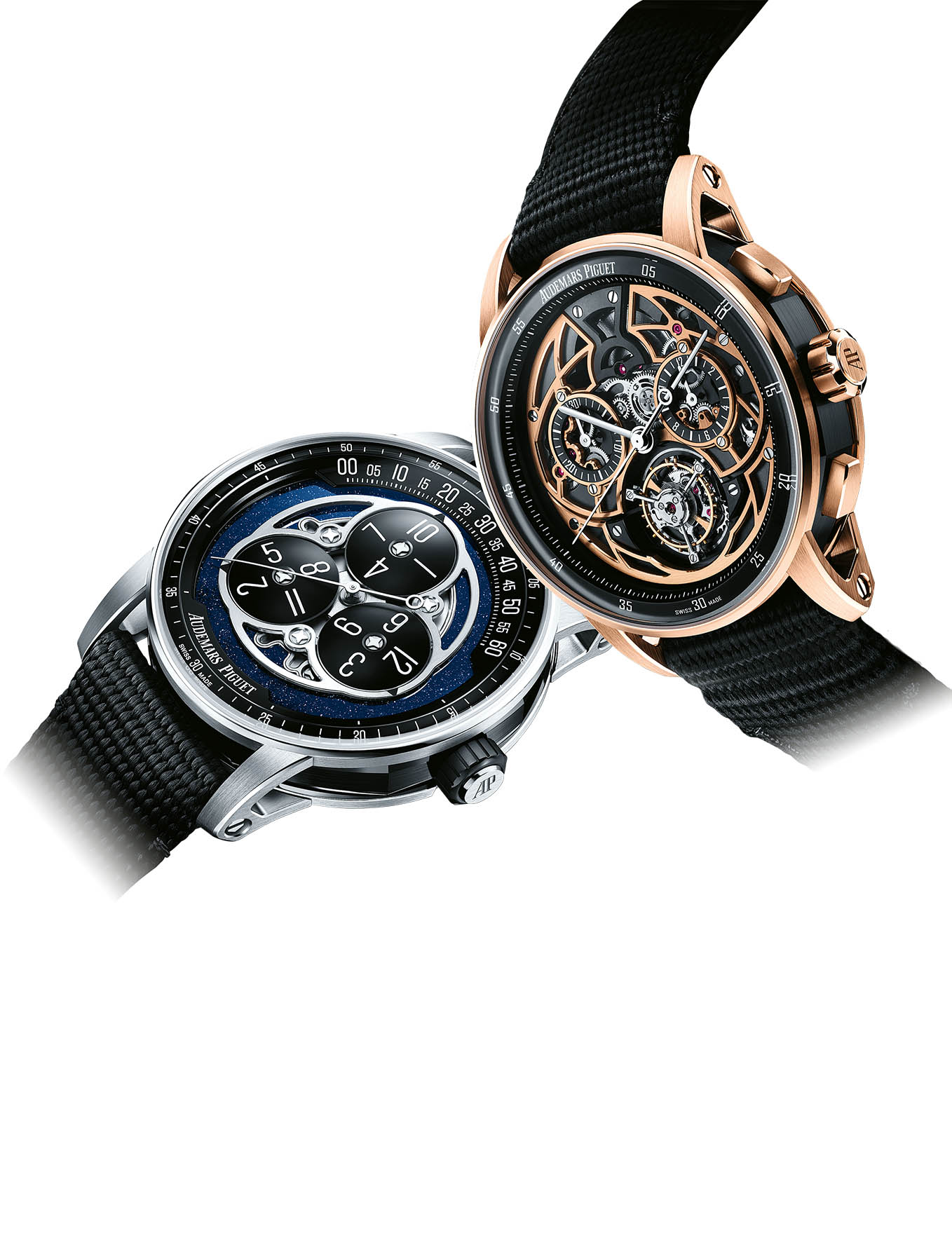 Audemars Piguet Code 11.59 Flying Tourbillon Chronograph (right) and Starwheel (below)
Audemars Piguet Code 11.59 Flying Tourbillon Chronograph (right) and Starwheel (below)In 2015, Audemars Piguet revealed a completely new timing function for interval timing with the Royal Oak Concept Laptimer Michael Schumacher Limited Edition. Pushers allow the two central stopwatch hands to be controlled separately. The additional pusher at 9 o’clock makes it possible to stop one of the two hands and reset and restart the other. When measuring and recording laps in motorsports, the timing of the next lap can start while recording the result of the intermediate event. With a normal split-seconds chronograph, it is possible to measure intermediate events. However, if you press the pusher for the split-seconds hand, it will stop one of the two second hands while the other continues to run and does not return to zero to start a new lap.
Watchmakers agree that the most difficult complication to bring to life is the minute repeater. In addition to a complex system to determine the time and chime the hours, quarter hours, and minutes, the sounds it produces must be both beautiful and clear. For the Royal Oak Concept Supersonnerie, Audemars Piguet reworked the entire minute repeater mechanism. The innovative chiming watch attaches the gongs to a soundboard membrane, and the caseback with sound holes functions as a second board. On the wrist, these openings direct the sound outward where it is reflected. This actually amplifies the sound when the watch is being worn.
The anchor escapement mechanism, which regulates the running speed of the chiming mechanism, often causes an additional problem—a disturbing noise. A newly developed, flexible anchor governor prevents the pivot from vibrating, which is the cause of the noise. Audemars Piguet also addressed another weakness of repeaters: You can damage the mechanism when adjusting the time while the watch is chiming.
For this reason, the Supersonnerie has a lever that prevents you from pulling the crown during the chiming process. And, a new production method for the gong produces an especially pure and pleasing tone.
While most repeaters cannot keep water from entering the movement, the Supersonnerie is water resistant to 30 metres. And the latest Audemars Piguet innovation is a system that prevents the pause that normally occurs when there is no quarter hour to chime. Audemars Piguet watchmakers also integrated a tourbillon and a chronograph in the Supersonnerie.
Thin complications require a high level of effort to develop and special expertise in assembly. In 2018, Audemars Piguet introduced the exciting prototype Royal Oak RD#2, at the time the thinnest perpetual calendar with an automatic movement, measuring only 6.3 mm in height. The special challenge presented by this concept watch was arranging all the perpetual calendar components on a single plane. With the in-house 5133 movement, Audemars Piguet successfully built a self-winding movement whose 256 parts measured only 2.89mm in height.
Patek Philippe also develops innovative complications, such as the annual calendar in 1996 and the updated time-zone function for the Aquanaut Travel Time Ref. 5650G Advanced Research launched in 2017. The new system for setting local time with two pushers replaces a complicated steel component with several springs and levers, thereby reducing friction, wear, errors, and energy consumption. The mechanism is also considerably thinner.
Elegant Models
These two brands pursue very different strategies when it comes to their elegant dress watch collections. While Patek Philippe continues to offer its classic Calatrava watch in a number of different variations, Audemars Piguet added the Code 11.59 to its program in 2019. The Code 11.59 is more elegant than the Royal Oak, and with its openwork lugs and special typography, it puts forth considerably more modern accents than the mid-century Calatrava design. And by partially removing the dial to reveal the skeletonized movement from the front, Audemars Piguet is actively following current trends.
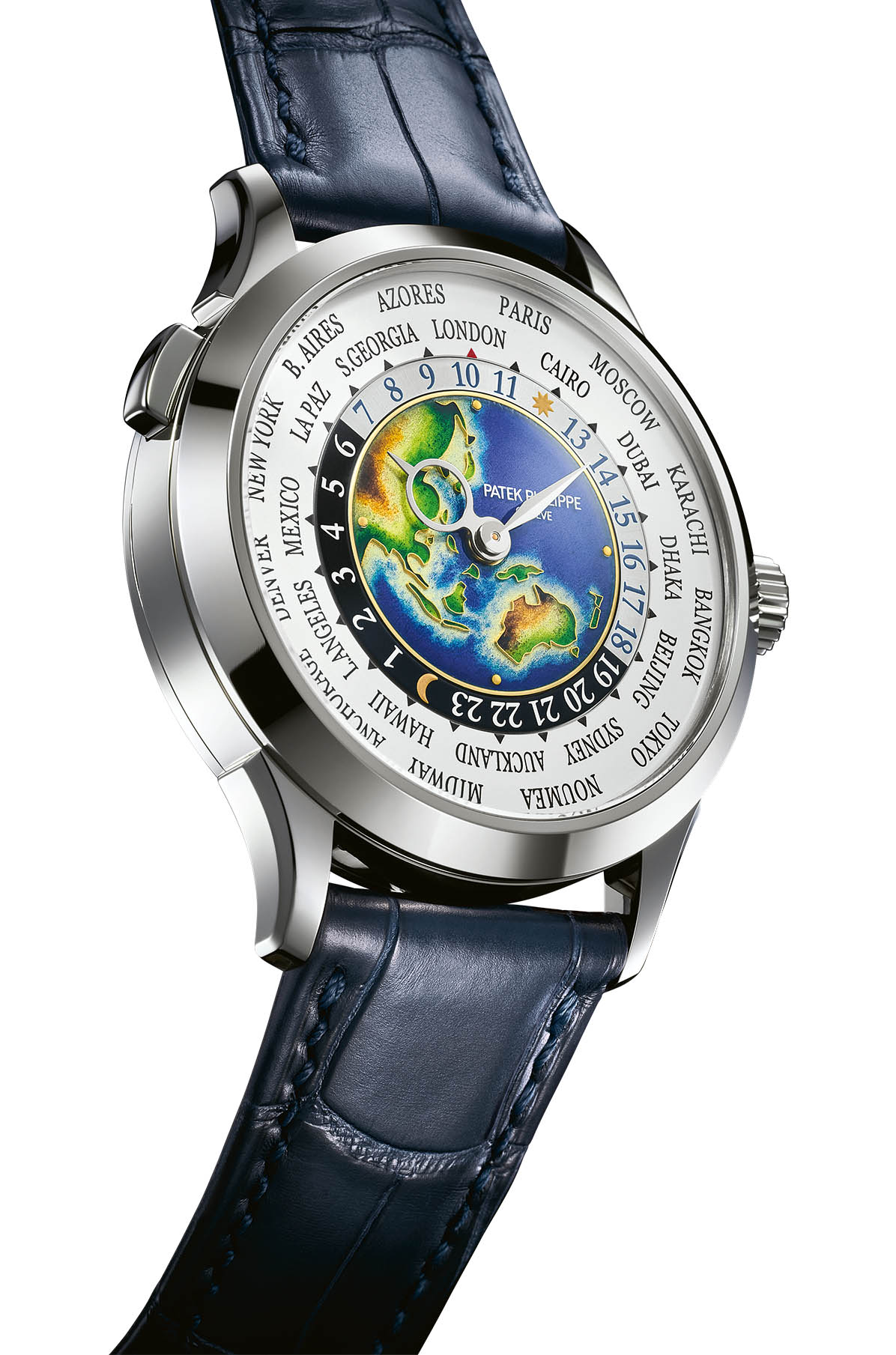 Patek Philippe Worldtimer
Patek Philippe WorldtimerBoth manufacturers provide their more elegant models with mechanical complications like chronographs. Patek is known for the easy-to-use second time zone, the world-time indication and the annual calendar. Audemars employs an exposed tourbillon, a perpetual calendar and a minute repeater. Also, the unusual display, showing three satellites with four hour numerals and minutes on a retrograde 90-degree track, has been available again since late 2022.
All in all, the selection of models and complications in the elegant sector is considerably larger at Patek Philippe, and that was Thierry Stern’s intention. Both brands have moved away from each other over the years and positioned themselves differently. Audemars Piguet presents a more modern face with the integration of pop culture and a focus on its iconic Royal Oak. Patek Philippe remains more classic in design, relying on many complications and attempting to control the hype around its icon, the Nautilus, more restrictively. But the two brands have one thing in common: They both manage to pursue commercially extremely successful strategies, and they have both successfully managed to attract the next generation of watch buyers.
This story was previously published in WatchTime India's Oct-Dec 2023 issue.
Images: Courtesy brands






















